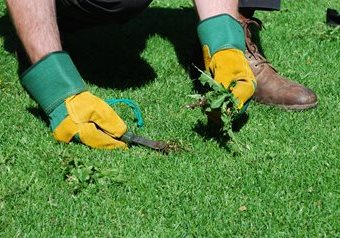Home / Information & advice / Turf & Lawns / Lawn aftercare / Broadleaf weeds in your turf

If you answer yes to the above questions, your lawn has broadleaf weeds growing in it. Read on to learn how to determine which weed(s) you might have and how to rid your lawn of them.
Weeds establish themselves in your turf because the turf is thin (sparse) and open (soil is visible). The seeds of weeds are everywhere turf is grown, but a thick, healthy turf will prevent most weeds from growing. Weeds do not ‘like’ to compete with a strong, thick turf. If you have weeds in your turf when it is delivered, you have purchased poor quality turf. However, before you call your landscaper or turf producer, check to see if the weeds are growing up through the joints or on the edges of your turf. If the weeds are there, your turf installation was not as good as it should have been. Weed seeds will be in the ground that you laid your turf on. Most seeds can not easily germinate and grow through quality turf, but once in a while they do. To minimise weed seeds from growing up through your new turf, prepare your soil properly.
If weeds appear in turf that was laid more than a year ago, it is because the turf has become thin (sparse) or damaged. When a weed seed can fall to the soil and has room to grow, it will. The best way to prevent weeds from getting established is to maintain a thick and healthy turf. Fertiliser and the lawnmower are your best tools for this job.
Once weeds are in your turf, you need to remove them. There are two ways to remove them: dig them out; or kill them with a herbicide. There is nothing wrong with digging them out, and it is good exercise and environmentally safe. Most of the common weeds that appear in lawns will dig out easily if the soil is moist, but a few will not and these need to be sprayed. When digging a weed out, it is best to use a sharp knife or weed digging tool (both can be found in a garden centre). Slide the knife down under the weed and cut off the root. Then, pull the weed out and discard it away from your turf. If you leave the weeds on or near your turf, they could discharge their seeds, and your problem will grow again.
Dandelions, buttercup, and daisies can be easily dug out of your turf, but clover is difficult to remove with a knife. To remove clover, a herbicide is generally used. You should dig up a small sample of the weed you want to remove from your turf and take it to your garden centre expert. They will tell you what it is and what to use to control it. When weeds are treated with a herbicide (weedkiller), it will take them more than a week to die. After they are dead, you can rake up the dead plants and discard them.
After the weeds are removed, care for your turf properly. If your turf was mostly weeds or if there are bare spots in your turf, you may need to purchase a new turf or overseed.
The best method is to grow thick, healthy turf, but you can also use selective herbicides to control some weeds. Weed controlling herbicides are applied like fertiliser, and this is usually done in the spring. Check with your garden centre expert for advice on these products.

Overseeding as part of your annual lawn maintenance regime will give your lawn a denser sward and help prevent weeds encroaching.
Always start with quality turf. If the soil under your turf is exposed, weeds will grow there. Good gardening and turf care are the best methods to prevent weeds from invading your turf.
Further lawn care advice can be found in our Information Centre. You can also sign up for lawn tips to receive regular lawn care advice, news and promotional offers by email which will help you get the best from your lawn.
For more techniques to help you maintain a healthy lawn, explore our other lawn aftercare advice.
You can also sign up to our newsletter to receive free seasonal lawn care advice and reminders of essential maintenance, as well as general horticultural advice and special offers from Rolawn.